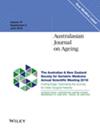Sit-to-stand and stand-to-sit kinematics in older adults with and without functional disability: A principal component analysis
Abstract
Objective
Sit-to-Stand (Sit-TS) and Stand-to-Sit (Stand-TS) transitions are essential daily movements affected by ageing and disability. This study aimed to explore related kinematic domains in older adults with and without disability.
Methods
A cross-sectional study including adults aged 60 years or older, with (n = 25) and without disability (n = 35). Comparisons between groups included task time, centre of mass (CoM) acceleration, postural sway and principal component (PC) scores for each task. Principal component models (PCMs) included lower limb and trunk tridimensional joint ranges of motion, angular velocity range, CoM displacement and velocity along each Sit-TS (flexion, momentum transfer, extension and stabilisation) and Stand-TS (initiation, flexion, momentum transfer and extension) phases.
Results
Older adults with functional disability exhibited increased Sit-TS peak antero-posterior CoM acceleration (p = .02). The Sit-TS and Stand-TS PCMs included nine PCs each. In Sit-TS, the first three explained half the variance: PC1 captured transverse hip and knee stabilisation kinematics, PC2 described trunk and hip frontal and transverse control during flexion, and PC3 represented sagittal knee and ankle control during momentum transfer and extension. In Stand-TS, variance was more distributed (PC1 describing frontal hip and knee flexion velocity, PC2 sagittal trunk and hip extension velocity, and PC3 vertical CoM velocity at extension). Significant group differences emerged in PC4 (transverse knee and frontal hip kinematics) and PC9 (sagittal and frontal trunk angular velocity ranges during momentum transfer).
Conclusions
Both transitions revealed distinct joint and trunk control demands. Principal components involving transverse knee, frontal hip and trunk angular velocities distinguished disability groups, with Stand-TS showing greater discriminative power.


 求助内容:
求助内容: 应助结果提醒方式:
应助结果提醒方式:


